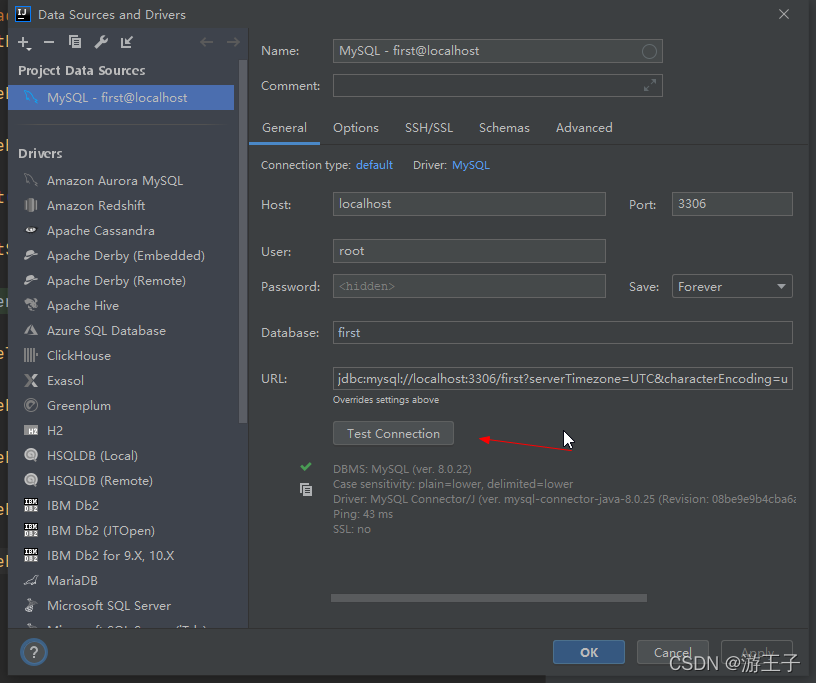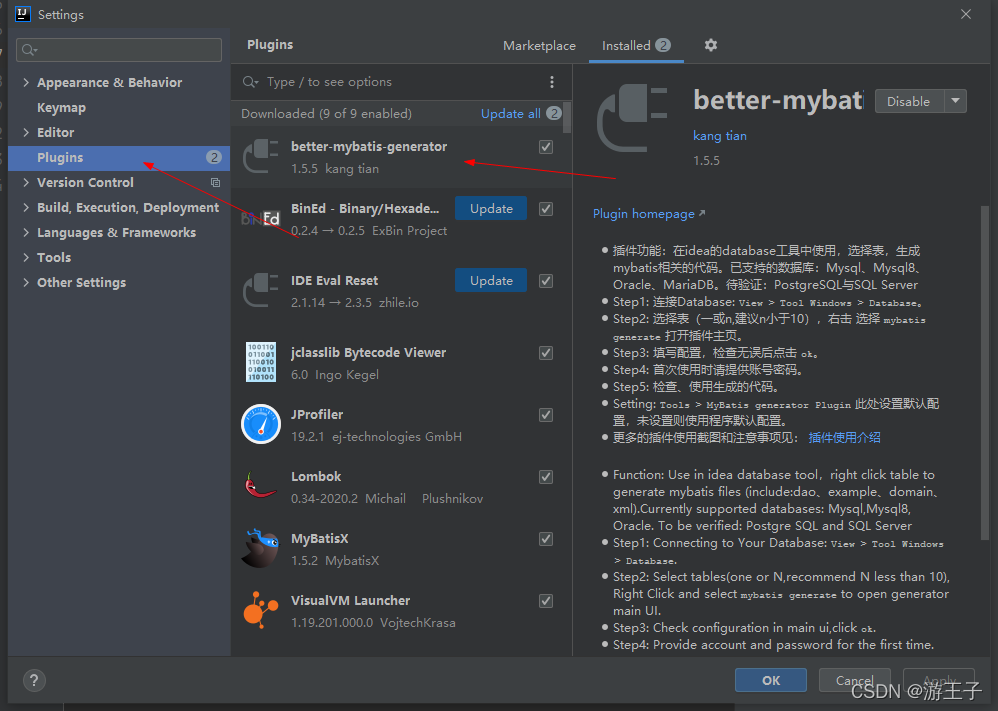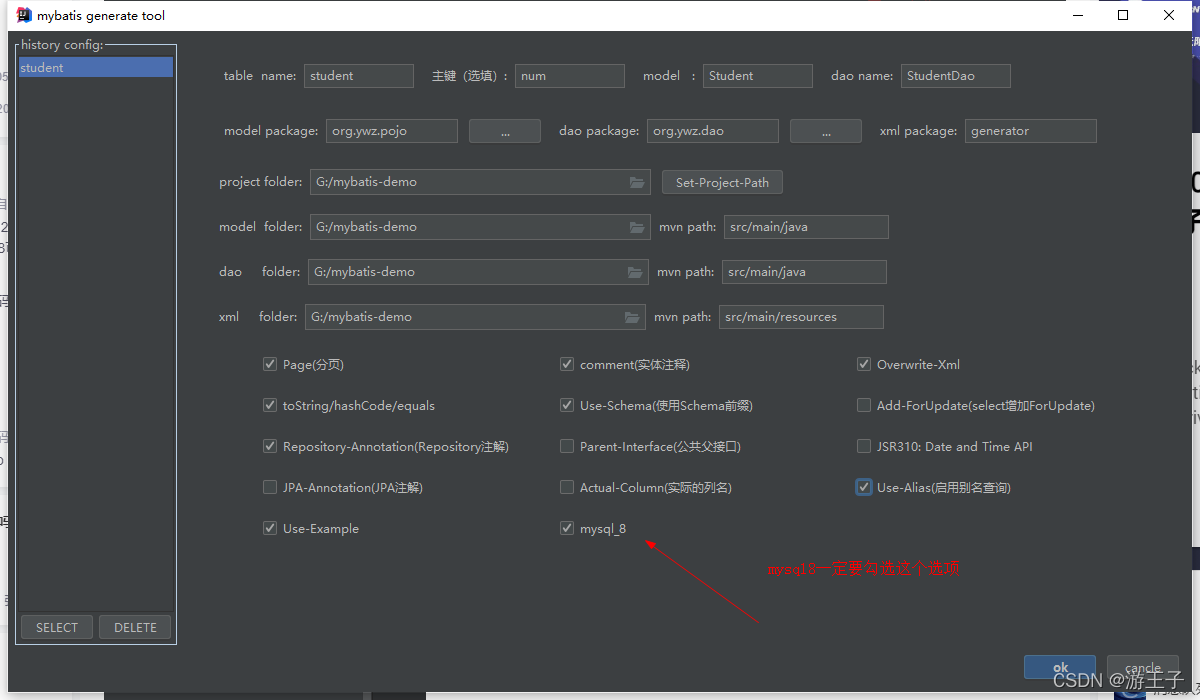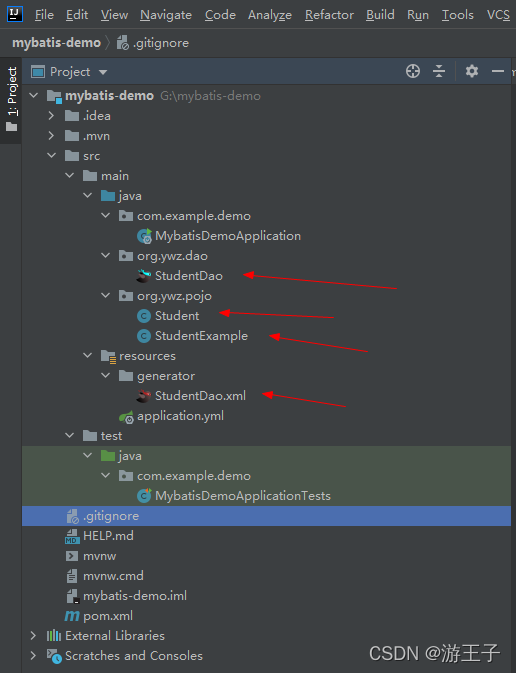idea怎么使用Mybatis逆向工程插件,很多新手对此不是很清楚,为了帮助大家解决这个难题,下面小编将为大家详细讲解,有这方面需求的人可以来学习下,希望你能有所收获。

添加连接的mysql的信息,测试链接成功即可。


安装成功后,在需要生成的表上右键选择mybatis-generator。

添加要生成的一些配置。

点击OK,第一次生成会弹出窗口,需要输入数据库的帐号密码。可以看到生成该表对应的mapper接口、实体类和sql。

mybatis-generator会为每个字段产生Criterion,为底层的mapper.xml创建动态sql。如果表的字段比较多,产生的example类会十分庞大。理论上通过example类可以构造你想到的任何筛选条件。
//作用:升序还是降序 //参数格式:字段+空格+asc(desc) protected String orderByClause; //作用:去除重复 //true是选择不重复记录,false,反之 protected boolean distinct; //自定义查询条件 //Criteria的集合,集合中对象是由or连接 protected List<Criteria> oredCriteria; // 分页的显示条数 private Integer limit; // 分页的起始下标 private Long offset; //内部类Criteria包含一个Cretiron的集合, //每一个Criteria对象内包含的Cretiron之间是由 AND连接的 public static class Criteria extends GeneratedCriteria { protected Criteria() {super();} } //是mybatis中逆向工程中的代码模型 protected abstract static class GeneratedCriteria {......} //是最基本,最底层的Where条件,用于字段级的筛选 public static class Criterion {......}在MybatisDemoApplicationTests类中进行测试:
package org.ywz.test; import org.junit.jupiter.api.Test; import org.junit.platform.commons.util.StringUtils; import org.springframework.beans.factory.annotation.Autowired; import org.springframework.boot.test.context.SpringBootTest; import org.ywz.dao.StudentDao; import org.ywz.pojo.Student; import org.ywz.pojo.StudentExample; import java.util.List; /** * Example类使用说明 */ @SpringBootTest class MybatisDemoApplicationTests { @Autowired private StudentDao studentDao; @Test void contextLoads() { StudentExample studentExample = new StudentExample(); // 查询数据的总条数 类似于:select count(*) from student long l = studentDao.countByExample(studentExample); System.out.println("---------------总条数----------------"); System.out.println("数据库的总条数:" + l); System.out.println("----------------and条件---------------"); // where条件查询或多条件查询 Student student = new Student(); student.setName("王五"); student.setSex("男"); selectAndCondition(student); System.out.println("---------------or条件----------------"); selectOrCondition(student); System.out.println("-----------------模糊查询--------------"); student.setName("王"); selectLikeCondition(student); System.out.println("-----------------分页查询--------------"); selectLimit(); } /** * where条件查询或多条件查询 * 类似于:select * from student where name={#student.name} and sex={#student.sex} order by score asc; * * @param student */ private void selectAndCondition(Student student) { StudentExample studentExample = new StudentExample(); StudentExample.Criteria criteria = studentExample.createCriteria(); studentExample.setOrderByClause("score asc"); //升序 studentExample.setDistinct(false); //不去重 if (StringUtils.isNotBlank(student.getName())) { criteria.andNameEqualTo(student.getName()); } if (StringUtils.isNotBlank(student.getSex())) { criteria.andSexEqualTo(student.getSex()); } List<Student> students = studentDao.selectByExample(studentExample); students.forEach(System.out::println); } /** * 类似于:select * from student where name={#student.name} or sex={#student.sex} ; * * @param student */ private void selectOrCondition(Student student) { StudentExample studentExample = new StudentExample(); StudentExample.Criteria criteria1 = studentExample.createCriteria(); StudentExample.Criteria criteria2 = studentExample.createCriteria(); if (StringUtils.isNotBlank(student.getName())) { criteria1.andNameEqualTo(student.getName()); } if (StringUtils.isNotBlank(student.getSex())) { criteria2.andSexEqualTo(student.getSex()); } studentExample.or(criteria2); List<Student> students = studentDao.selectByExample(studentExample); students.forEach(System.out::println); } /** * 类似于:select * from student where name like %{#student.name}% * * @param student */ private void selectLikeCondition(Student student) { StudentExample studentExample = new StudentExample(); StudentExample.Criteria criteria = studentExample.createCriteria(); if (StringUtils.isNotBlank(student.getName())) { criteria.andNameLike("%" + student.getName() + "%"); } List<Student> students = studentDao.selectByExample(studentExample); students.forEach(System.out::println); } /** * 类似于:select * from student limit offset,limit */ public void selectLimit() { StudentExample studentExample = new StudentExample(); studentExample.setOffset(2l); studentExample.setLimit(5); List<Student> students = studentDao.selectByExample(studentExample); students.forEach(System.out::println); } }运行结果:

看完上述内容是否对您有帮助呢?如果还想对相关知识有进一步的了解或阅读更多相关文章,请关注亿速云行业资讯频道,感谢您对亿速云的支持。
免责声明:本站发布的内容(图片、视频和文字)以原创、转载和分享为主,文章观点不代表本网站立场,如果涉及侵权请联系站长邮箱:is@yisu.com进行举报,并提供相关证据,一经查实,将立刻删除涉嫌侵权内容。